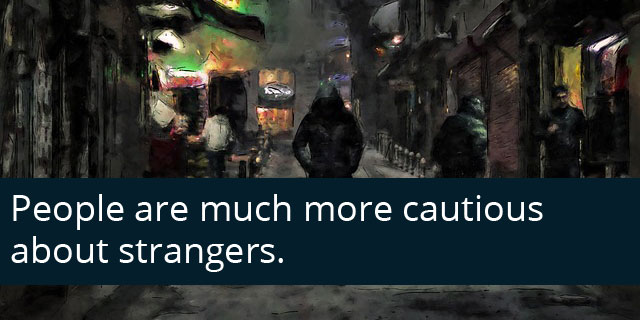It seems as though serial killers in the United States reached a “peak” during the 1970s and 1980s. Notorious murderers such as Ted Bundy, Gary Ridgway, John Wayne Gacy, Samuel Little, Wayne Williams and Jeffrey Dahmer all began to commit their crimes during this period of time.
However, since the late 1980s, the act of serial killing has been on a noticeable downward trend.

Why is this?
Most likely, it’s due to a combination of reasons. However, if we can understand some of these reasons, then we can change the topic of conversation from “how to catch a serial killer” to “how to prevent a serial killer”.
Forensics have improved.
Advances in forensics and the introduction of DNA profiling have made it a lot more difficult for murderers to get away with their crimes. Therefore, it is probable that “would-be” serial killers are being apprehended earlier in their crime sprees.
If a serial killer from the 1970s were to time travel to this day and age, they would undoubtedly find it a lot more difficult to avoid detection.
A single strand of hair at a crime scene can be enough to put someone away for the rest of their life. Heinous crimes such as rape also tend to leave behind trace evidence that can be cross-referenced against DNA databases.

DNA profiling started to become popular in the late 1980s and 1990s.
Although there is a common misconception that many serial killers are evil geniuses, this is simply not the case.
In fact, a lot of serial killers are impulsive creatures who have a low or average IQ. Consequently, a lot of murderers and rapists end up making mistakes that lead to their capture.
Simply put, advancements in forensic science have stacked the deck against these kinds of killers.
Technology is far more widespread.
CCTV footage is far more widespread than it ever has been. Furthermore, the quality of CCTV footage has been steadily improving over the past few decades.
Many apartment blocks, garages, streets, parks and private homes have CCTV cameras fitted to deter burglars, shoplifters and vandals.
As a result, a person who commits a serious crime such as murder is far more likely to be “picked up” by a camera in the area.
Imagine if a neighbor’s CCTV camera had captured Ted Bundy getting into his car after one of his earlier murders. He might not have had the chance to become the notorious serial killer that we now know him as.

Technology has made it difficult for serial offenders to go undetected.
Besides CCTV, we also have GPS and other location tracking systems on cars and cellphones. A suspect who denies being in a certain area can be undone by evidence that their phone pinged a local cell tower. A missing person’s location can be pinpointed by the GPS signal on their phone.
Similarly, vehicles with inbuilt navigation systems can keep a record of where the car has been. As a result, a killer who isn’t savvy enough to realize this could end up providing police with a detailed map of every location that he has visited.
Nowadays, people’s homes are far more likely to be protected by alarm systems.
If Richard Ramirez’s home invasion crime spree took place today, he would undoubtedly find it far more difficult to avoid being detected. It would only be a matter of time before he’d set off an alarm system or get captured by someone’s WiFi camera.
Peeping toms.
Serial killers such as Ted Bundy, Joseph DeAngelo and Dennis Rader (BTK) started off as peeping toms. This behavior then escalated into breaking into homes and stealing stuff.
It is rare for someone to immediately become a serial killer. They usually commit lesser crimes and continue to push boundaries until they finally pick up the courage to carry out their first murder.
It is possible that modern technology and home security systems have disrupted this kind of “evolution”. As a result, someone who has the potential to “evolve” into a serial killer might not get the chance to do so.
In his younger days, Ted Bundy used to drink large amounts of alcohol before “canvassing” his local neighborhood for windows to peer into. However, in this day and age, that kind of behavior is less likely to go undetected.
If Bundy had avoided voyeurism out of a fear of being caught on CCTV, he might not have evolved into the monster that he became.
For example, if a neighbor’s CCTV camera had captured him spying through a window, the resulting backlash might have convinced him to steer clear of that kind of behavior.
Prostitution has started to move online.
Sex workers no longer have to stand on the street and wait for random passersby to stop and pick them up. Instead, they are increasingly moving online, where they can create profiles and force clients to contact them by phone. In many cases, they will also vet their clients and ask for identification before meeting up.
Sex workers have always been a target for serial killers because they are accessible and vulnerable. They are also transient by nature, which means that people are less likely to notice it when they go missing.
Serial killers such as Gary Ridgway, Arthur Shawcross and Samuel Little all preyed on sex workers.
Because prostitution has continued to move online, sex workers are becoming less of an easy target for killers.
Although it is possible to use a throwaway phone number or a fake IP address, this requires more sophistication and knowledge on the killer’s part. And as I mentioned above, most serial killers are not as smart as Hollywood has made them out to be.
Even technologically-savvy people find it difficult to remain completely anonymous on the Internet. One simple mistake or misunderstanding about how the Internet works and there is now a trace back to your identity.
All in all, it’s a much riskier “hunting ground”.
People have become far less trusting of strangers.
People often talk about the “good old days” when you could leave your front door unlocked and hitchhiking was a viable means of transport. A time when children and teenagers played outside for hours on end with no contact from their parents.
However, in modern times, we have learned to become far less trusting of strangers. We have also become more protective of our kids. From an early age, the concept of “stranger danger” has been drilled into us. Movies, TV shows and documentaries have shown us how various serial killers operated.
We now know that these killers can look and act normal. We’ve grown up with warnings about kidnappers. Many women will now avoid walking on their own in dark or secluded areas. All in all, we’ve become far more aware of how murderers, rapists and other dangerous criminals can take advantage of us.
Because of this increased vigilance, there are now less opportunities for predators.

People are far more cautious about strangers.
Take the following case as an example. Serial killer Ed Kemper used to pick up female college students who were hitchhiking.
He would then take them to a secluded spot and murder them. In modern times, Kemper would not have had this opportunity as it is extremely rare to come across young women who are hitchhiking on the side of the road.
Instead, he would most likely have to pursue another approach. And that approach could bring with it an increased risk of being caught.
Mental health is being taken more seriously.
Our attitudes towards mental health have continued to improve over the past couple of decades. There is no longer a social stigma around seeing a therapist or taking psychiatric medication.
In addition, we have also become better at diagnosing and treating disorders.
Jeffrey Dahmer.
For example, if Jeffrey Dahmer had been born in the 1980s or 1990s, his psychosis and schizotypal disorders could have been identified sooner. He would have also been more likely to confront his mental health problems instead of becoming dependent on alcohol.
If Dahmer had been born later, his morbid fascination with dead animals during childhood might have raised red flags. An intervention by a child psychologist or a therapist could have been enough to divert him away from the course that he was on.
What “makes” a serial killer?
A person does not become a serial killer for one reason. Instead, it seems as though the “perfect storm” has to take place. This can include:
- Childhood trauma.
- Social isolation as a child.
- Unhealthy fixations and fantasies about sexual scenarios that most people would find disgusting or abnormal.
- Mental illnesses such as psychopathy or schizophrenia.
- Constant fantasies about power and violence.
- An escalation of crimes such as theft, fire setting, vandalism and voyeurism.
- An event or “stressor” that “pushes them over the edge” and makes them act on their urges for the first time.
Even if a person does tick all of the boxes above, it still doesn’t mean that they will become a serial killer. It’s not that simple. Similarly, a serial killer might not always fit all of the points above.
For example, there have been a number of cases where serial killers had no noticeable trauma or abuse in their past. Sociopaths also exist in all walks of life. However, most of them have zero urge to kill.
Improvements in living standards.
However, what if our recent transition from lobotomies and electroshock therapy to a focus on addressing chemical imbalances in the brain has been enough to remove some of these “ingredients”?
Experts now believe that certain disorders are born out of “psychological stressors”. Poor living conditions, unemployment and troublesome interpersonal relationships are all examples of “stressors”. What if these stressors are simply less prevalent in modern times?
We know that poverty in the USA fell from the 1950s onwards and that the average standard of living increased. Furthermore, leisure time increased and products such as televisions, freezers and washing machines became more accessible to the average American worker.
By the 1990s, the average standard of living in America had become one of the highest in the world. Notorious serial killers such as Ted Bundy, John Wayne Gacy, Gary Ridgway and Samuel Little all grew up during the 1940s and 1950s, when poverty was higher and the standard of living was much lower than what it is today.
Would we still know their names if they had all been born 20 years later? Possibly not.
Addressing some of the disorders that can “create” a serial killer.
Nowadays, we are much better at addressing the disorders that make up this dangerous “cocktail”. For example, cognitive behavioral therapy can be used to help people develop strategies to avoid acting on their sexual perversions.
There is also medication that can lower a person’s sex drive and reduce their fantasies. Better treatments for schizophrenia, paranoia and psychosis also exist.
All in all, we have improved how we treat personality disorders and mental illnesses.
The serial killer’s parents.
In many circumstances, it was also the killer’s parents who had mental health issues.
Ted Bundy’s father figure, Samuel Cowell, was a violent man who spoke to unseen presences. Jeffery Dahmer’s mother was a hypochondriac who suffered from depression and tried to commit suicide. John Wayne Gacy’s father was an alcoholic who was physically abusive.
Would these killers have grown up in more stable homes if their parents had been properly treated for their mental health issues?
Child protective services have improved over the years.
A lot of serial killers grew up in broken homes and suffered from childhood trauma:
- Henry Lee Lucas’ mother was a prostitute who would make him watch as she had sex with her clients. She would also force him to wear girl’s clothes to school.
- John Wayne Gacy’s father was an alcoholic who physically abused his wife and children.
- Ted Bundy grew up believing that his mother was his sister. As mentioned above, Bundy’s father figure, Samuel Cowell, was a violent man who swung neighborhood cats by their tails and spoke to unseen presences in the room. He also used to beat his wife, and on one occasion, he threw Bundy’s aunt down the stairs.
- At the age of 13, Gary Ridgway’s domineering mother used to wash his genitals whenever he wet the bed. His parents also used to get into violent fights.
- The Genesee River Killer, Arthur Shawcross, claims that he was sexually abused by his mother when he was a child.
As you can see, these men didn’t exactly have “normal” childhoods.
Child protective services were a lot more primitive in the 1950s and 1960s than they are today.
Unfortunately, it wasn’t until the 1960s that a professional inquiry was held into the topic of child abuse. Furthermore, it took another decade before Congress passed federal legislation “to prevent, identify and treat child abuse and neglect.”
Essentially, many of these serial killers grew up during a time when doctors generally accepted the parent’s explanation for an injury. “He fell down the stairs” would have gone unchallenged.
This begs the question: If child protective services had been more advanced back then, would these men have still gone on to become serial killers? What if Henry Lee Lucas had been removed from his mother’s care after it became clear that she was forcing him to cross-dress in public? What if John Wayne Gacy had been removed from his father’s care at an early age?
Prison sentences and the parole system are less forgiving.
Last but not least, the prison system is far stricter than it was in the past. As I mentioned above, many of these killers didn’t start off with murder. Instead, they engaged in lesser crimes and evolved. Each crime gave them the confidence to “progress” to the next stage.
Psychology professor Mike Aamod at the Radford University developed a database of over 5,000 serial killers. His database shows that nearly 20% of serial killers were people who had killed in the past and been released from prison.
One example of this is Arthur Shawcross, who only spent 14 years in prison for raping and killing a young boy and a girl in his hometown of Watertown, New York. Inexplicably, Shawcross was paroled from prison in 1987, despite warnings from psychiatrists. Between 1988 and 1989, he went on to abduct and murder 12 women in Rochester.
In the modern prison system, a killer such as Shawcross would find it much more difficult to be granted parole. They’d also find it more difficult to trick psychiatrists into believing they’re no longer a threat to society. Furthermore, prisoners who do get granted parole are subject to far more drug testing, intensive supervision and unannounced visits than before.
Essentially, the justice system has become far more informed about the difficulties of rehabilitating sexual predators.
Conclusion.
Although serial killers haven’t disappeared, advancements in forensic science and technology have made it increasingly difficult for them to “ply their trade”. In this day and age, killers have to be a lot more sophisticated and knowledgeable if they want to avoid detection.
Thankfully, a lot of these predators are not intelligent enough to overcome these new challenges. It is likely that would-be serial killers are being caught and sent to prison much earlier than before.
At the same time, improvements in our society may have lessened the possibility of someone becoming a serial killer in the first place.